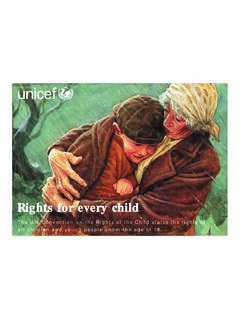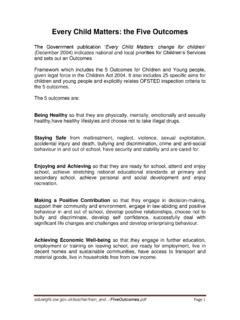Transcription of Where and why are 10 million children dying every year?
1 child SURVIVAL I. child survival I. Where and why are 10 million children dying every year ? Robert E Black, Saul S Morris, Jennifer Bryce More than 10 million children die each year , most from preventable causes and almost all in poor countries. Six countries account for 50% of worldwide deaths in children younger than 5 years, and 42 countries for 90%. The causes of death differ substantially from one country to another, highlighting the need to expand understanding of child health epidemiology at a country level rather than in geopolitical regions. Other key issues include the importance of undernutrition as an underlying cause of child deaths associated with infectious diseases, the effects of multiple concurrent illnesses, and recognition that pneumonia and diarrhoea remain the diseases that are most often associated with child deaths.
2 A better understanding of child health epidemiology could contribute to more effective approaches to saving children 's lives. Substantial reductions in child mortality occurred in low- commensurate with needs. The mortality reduction target income and middle-income countries in the late 20th was reached for only five of 55 countries with an under-5- century, but more than 10 million children younger than year mortality rate of 100 or more in 5 years still die every ,2 In this article, the first in a In 2002, as part of the millennium development goals series of five, we consider reasons for these deaths and for health, nations pledged to ensure a two-thirds provide recommendations for how they can be prevented.
3 Reduction in child mortality by 2015, from the base year Rates of decline in worldwide child mortality peaked in In addition to setting such a goal, the global public about In 1990 2001, the number of child deaths health community must critically assess how it can be fell by 1 1% every year , compared with 2 5% per year accomplished. A realistic picture of a country's during 1960 Although this deceleration might be epidemiological profile and the capabilities of its health expected in areas that had already achieved low rates of system is needed before appropriate public health mortality, such slowing has also occurred in high-rate interventions can be developed and implemented.
4 Regions. Sub-Saharan Africa had the highest child Development of these interventions also requires an mortality in 1970 74, but in the years since has had the understanding of the determinants of child mortality. slowest fall in South Asia also had a high rate of These determinants include, at the most distant level, child deaths in the 1970s, and despite a 50% drop in socioeconomic factors, such as income, social status, and mortality, almost one in ten children in this region still education, which work through an intermediate level of dies before their fifth environmental and behavioural risk These risk child mortality varies among world regions, and these factors, in turn, lead to the proximal causes of death differences are large and increasing.
5 In 1990, there were (nearer in time to the terminal event), such as 180 deaths per 1000 livebirths in sub-Saharan Africa and undernutrition, infectious diseases, and injury. In this only 9 per 1000 in industrialised countries a 20-fold paper, we will focus on proximal causes of death and on In 2000, this gap had increased to 29-fold selected environmental and behavioural risk factors. The with mortality rates of 175 and 6 per 1000 children in fourth article in this series will address the socioeconomic sub-Saharan Africa and industrialised countries, determinants of child mortality. The World Summit for children in 1990 called for a Where do most child deaths occur? worldwide reduction in child mortality to below 70 deaths The estimate for global child deaths in 2000 is per 1000 livebirths (or a one-third reduction if this yielded 10 8 In this series, data from 2000 will be used a lower mortality rate) by the year Unfortunately, throughout because they are most complete for this investments in health systems and interventions necessary period and little has changed in the past 2 years.
6 About to achieve such a reduction in the 1990s were not 41% of child deaths occur in sub-Saharan Africa and another 34% in south Because there is substantial variation in death rates within these regions, planning for health interventions should take place at a national Lancet 2003; 361: 2226 34 level. The incomplete and unreliable nature of these See Commentary page 2172. Johns Hopkins Bloomberg School of Public Health, Baltimore, MD, Search strategy USA (Prof R E Black MD); Department of Epidemiology and Population Health, London School of Hygiene and Tropical The search strategy for the model used to estimate Medicine, London, UK (S S Morris PhD); and 25 rue du Bugnon, proportionate causes of death has been St Genis-Pouilly, 10630 France (J Bryce EdD) Estimates of the importance of risk factors were taken from published For our comorbidity analyses we also Correspondence to: Prof Robert E Black, Department of International Health, Johns Hopkins Bloomberg School of Public Health, contacted researchers and directors of demographic Baltimore, MD 21205, USA surveillance areas in low-income and middle-income countries.
7 (e-mail: 2226 THE LANCET Vol 361 June 28, 2003 For personal use. Only reproduce with permission from The Lancet. child SURVIVAL I. Countries ranked by total Number of Under-5- year Countries ranked by under- Under-5- year mortality rate Number of child number of child deaths child deaths* mortality-rate rank 5- year mortality rate (per 1000 births) deaths rank India 2 402 000 54 Sierra Leone 316 36. Nigeria 834 000 17 Niger 270 12. China 784 000 88 Angola 260 11. Pakistan 565 000 43 Afghanistan 257 8. D R Congo 484 000 9 Liberia 235 51. Ethiopia 472 000 21 Mali 233 16. Bangladesh 343 000 57 5 Somalia 225 22. Afghanistan 251 000 4 Guinea-Bissau 215 70. Tanzania 223 000 23 D R Congo 205 5.)
8 Indonesia 218 000 76 5 Zambia 202 27. Angola 169 000 3 Chad 200 33. Niger 156 000 2 Mozambique 200 13. Mozambique 155 000 11 5 Burkina Faso 198 20. Uganda 145 000 36 Burundi 190 44. Myanmar 132 000 43 Malawi 188 25. Mali 128 000 6 Rwanda 187 42. Brazil 127 000 92 Nigeria 184 2. Kenya 125 000 39 Mauritania 183 59. Sudan 116 000 45 5 Central African Republic 180 54. Burkina Faso 104 000 13 Guinea 175 41. Iraq 104 000 34 Ethiopia 174 6. Somalia 100 000 7 C te d'Ivoire 173 24. Yemen 97 000 43 Tanzania 165 9. C te d'Ivoire 97 000 22 Benin 160 46. Malawi 96 000 15 Equatorial Guinea 156 89. Madagascar 93 000 30 5 Cameroon 154 28. Zambia 88 000 10 Djibouti 146 88. Cameroon 83 000 26 Swaziland 142 85.
9 Philippines 82 000 88 Togo 142 55. South Africa 77 000 66 5 Senegal 139 45. Nepal 76 000 54 Madagascar 139 26. Egypt 76 000 80 Cambodia 135 39. Chad 73 000 11 5 Lesotho 133 73. Iran 71 000 82 5 Iraq 130 21. Mexico 70 000 101 5 Gambia 128 79. Sierra Leone 69 000 1 Uganda 127 14. Turkey 66 000 80 Haiti 125 52. Ghana 65 000 49 East Timor 124 90. Cambodia 63 000 32 Kenya 120 18. Viet Nam 63 000 91 Zimbabwe 117 43. Guinea 62 000 20 Eritrea 114 63. Rwanda 54 000 16 Yemen 110 23. *Number of deaths estimated by multiplying the number of livebirths8 by the under-5- year mortality rate7 and by a life-table based adjustment factor that slightly reduces the number of deaths if the yearly number of births has increased over the previous quinquennium and slightly increases it if births have Decimal places indicate that two countries were equally ranked.
10 Table 1: Countries ranked by total child (under-5- year ) deaths or by under-5- year mortality rates in 2000. data in many countries can make this task difficult, so Risk factors for child mortality assessment of the needs and possible interventions Unhygienic and unsafe environments place children at risk for more homogeneous groups of countries is also of ,12 Ingestion of unsafe water, inadequate worthwhile. availability of water for hygiene, and lack of access to A few countries account for a very large proportion of sanitation contribute to about 1 5 million child deaths and all child deaths. In fact, half of worldwide deaths in around 88% of deaths from ,12 Other health- children younger than 5 years occur in only six countries, related behaviours, such as birth spacing, are also and 90% in 42 countries (table 1).


















